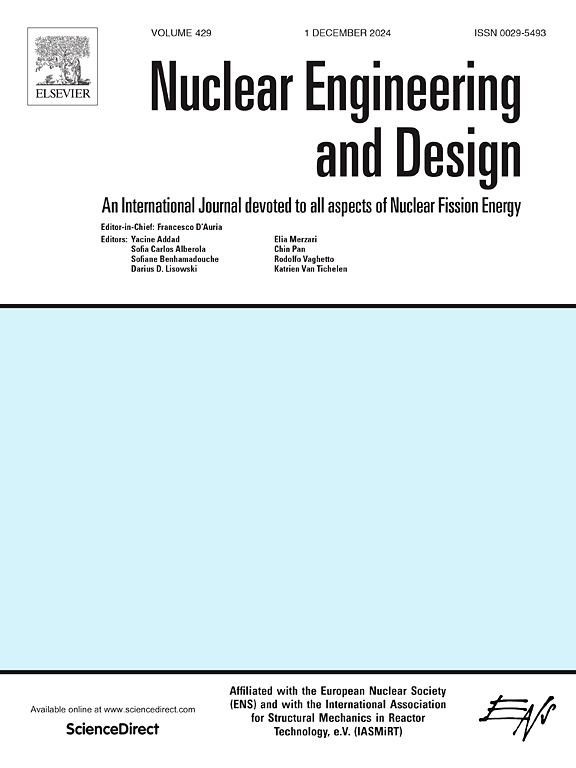Time-dependent neutron transport calculation with a parallel discontinuous finite element SN code SNIPER
IF 1.9
3区 工程技术
Q1 NUCLEAR SCIENCE & TECHNOLOGY
引用次数: 0
Abstract
Discontinuous finite element method (DFEM) based discrete ordinates (SN) is an important numerical method for solving time-dependent transport equation due to its geometry adaptivity and high accuracy. The parallel strategies of DFEM SN can be divided into Gauss-Seidel and block Jacobi. In this article, the parallel performance of several Gauss-Seidel parallel strategies and the block Jacobi strategy are compared and analyzed. The thresholds of fixed source scaling factor method (FSSFM) are analyzed through 2D C5G7-TD benchmarks. Also, a 2D time-dependent Fourier analysis is performed. Fourier analysis results show that the convergence behavior of time-dependent SN calculation is insensitive to the SN quadrature order. With the increase of the number of inner iterations, the spectral radius decreases. With the increase of fission-time term ratio w and scattering ratio c, the spectral radius increases. From the numerical results of the C5G7-TD benchmarks with a parallel SN code SNIPER, it can be concluded that the online-judged strategy achieves the highest parallel efficiency among several Gauss-Seidel parallel strategies. Block Jacobi parallel strategy saves about 30 % total time than the Gauss-Seidel strategy. Also, for transient calculation, FSSFM with reasonable thresholds decreases the number of outer iterations by an order of magnitude.
时变中子输运计算用平行不连续有限元SN代码SNIPER
基于离散坐标的不连续有限元法(DFEM)由于其几何适应性和精度高,是求解时变输运方程的重要数值方法。DFEM SN并行策略可分为高斯-塞德尔并行策略和块Jacobi并行策略。本文对几种Gauss-Seidel并行策略和块Jacobi并行策略的并行性能进行了比较分析。通过二维C5G7-TD基准测试,分析了固定源比例因子法(FSSFM)的阈值。此外,二维时间相关的傅里叶分析被执行。傅里叶分析结果表明,时变SN计算的收敛性对SN正交阶数不敏感。随着内迭代次数的增加,谱半径减小。随着裂变时项比w和散射比c的增大,光谱半径增大。利用并行SN码SNIPER对C5G7-TD基准测试的数值结果表明,在线判断策略在几种高斯-塞德尔并行策略中具有最高的并行效率。块雅可比并行策略比高斯-塞德尔并行策略节省约30%的总时间。此外,对于瞬态计算,具有合理阈值的FSSFM将外部迭代的次数减少了一个数量级。
本文章由计算机程序翻译,如有差异,请以英文原文为准。
求助全文
约1分钟内获得全文
求助全文
来源期刊

Nuclear Engineering and Design
工程技术-核科学技术
CiteScore
3.40
自引率
11.80%
发文量
377
审稿时长
5 months
期刊介绍:
Nuclear Engineering and Design covers the wide range of disciplines involved in the engineering, design, safety and construction of nuclear fission reactors. The Editors welcome papers both on applied and innovative aspects and developments in nuclear science and technology.
Fundamentals of Reactor Design include:
• Thermal-Hydraulics and Core Physics
• Safety Analysis, Risk Assessment (PSA)
• Structural and Mechanical Engineering
• Materials Science
• Fuel Behavior and Design
• Structural Plant Design
• Engineering of Reactor Components
• Experiments
Aspects beyond fundamentals of Reactor Design covered:
• Accident Mitigation Measures
• Reactor Control Systems
• Licensing Issues
• Safeguard Engineering
• Economy of Plants
• Reprocessing / Waste Disposal
• Applications of Nuclear Energy
• Maintenance
• Decommissioning
Papers on new reactor ideas and developments (Generation IV reactors) such as inherently safe modular HTRs, High Performance LWRs/HWRs and LMFBs/GFR will be considered; Actinide Burners, Accelerator Driven Systems, Energy Amplifiers and other special designs of power and research reactors and their applications are also encouraged.
 求助内容:
求助内容: 应助结果提醒方式:
应助结果提醒方式:


